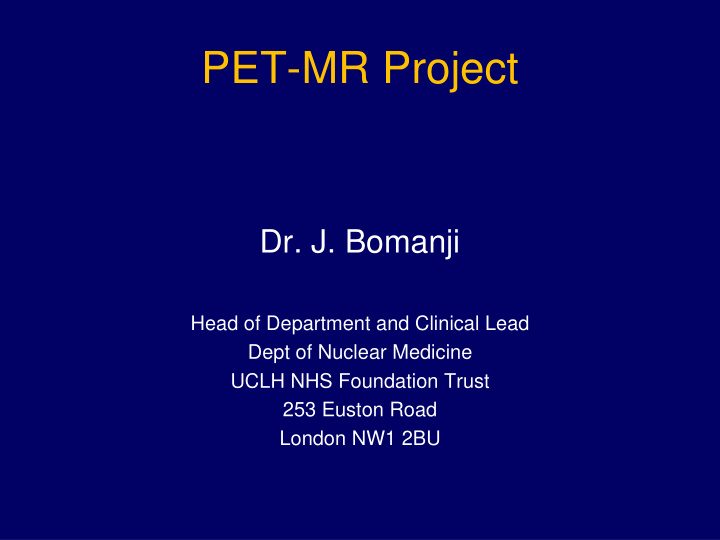



PET-MR Project Dr. J. Bomanji Head of Department and Clinical Lead Dept of Nuclear Medicine UCLH NHS Foundation Trust 253 Euston Road London NW1 2BU
The Institute of Nuclear Medicine Lead Innovation; Contribute sustainable value for patients and society; Network nationally and internationally Quality service To remain the UK’s Patients experience leading Institute for Research is first priority; Nuclear Medicine – in Clinical Service, Education Latest technology Research and Education PET-MR Align services and innovation objectives; Adapt service configuration to market needs; Develop staff to full potential; Maintain financial viability; Support highest standards in service outcomes and audit
PET-MR PROJECT Nuclear Medicine • Sept 2009: space in Macmillan Cancer Centre (PET/CT) no PET-MR machine available • Feb 2010: PET-MR machine available from Siemens • June 2010: MCC space reconfigured • July 2010: Trustees offer to buy and pay for PET/MR machine installation • Sept 2010: Visit to Erlangen, Siemens Factory
PET-MR PROJECT Business Case (Nov-Dec 2010) Tom Wright & Martin Lerner Assumptions • Approximately 8 patients/day • Price Tariff similar to a PET/CT/MRI (£ 1500/-) • Replace machine in 7yrs (Capital gift) • Clinical Indications: unclear Time: 60% Clinical, 40% Research Seed money of ~ £1.2 million required from CBRC (Research)
PET-MR PROJECT • Approximately a £6 million project • Dec 2010, Business case submitted for Board Approval. • Dec 2010, Trustees place order • Feb 2011, Board of Directors ratify programme • Time-lines: • Sept 2011, Machine delivery • Jan 2012, Building handover • April 2012, Clinical patients
PET-MR PROJECT Management (Nuc Med) • FUNDING: Tom Wright • DESIGN: Wendy Waddington • INSTALLATION: Wendy Waddington • COMPLIANCE: Wendy Waddington • RECRUITMENT: TW, WW, JB, S.Punwani • CLINICAL WORK FLOW: Caroline Townsend/ Medics • RESEARCH: Prof A. Groves, Dr. S. Punwani (Themes: Oncology, Neurology, Cardiology)
PET-MR PROJECT PARTNERS • Radiology • Clinicians • Medical Physics • The Centre for Advanced Biomedical Imaging • The Centre for Medical Image Computing
PET-MR PROJECT A Big Thank You to UCLH Trustees Sir Robert Naylor (CEO) Dr. Geoff Bellingham (MD) Prof. Mark Emberton Martin Lerner All members of Management/ IT SKANSKA
PET-MR Imaging CLINICAL and RESEARCH THEMES • Oncology • Neurology • Cardiology • Infection/Inflammation
Biograph mMR The world’s only simultaneous, whole- body molecular MR
two is now one. Resulting in… – One exam – One room – One whole-body solution – For shorter exams – Easier scheduling – And faster results
PET-MR Project Potential applications, now a reality. Neurodegenerative disease Clinicians have proposed a vast range of Head/Neck cancers applications where PET- MR will make a Cardiac evaluation difference. Liver metastasis Whole-body oncology Colorectal cancers Pediatric* oncology Bone metastasis Prostate cancer Bone and soft tissue lesions * MR scanning has not been established as safe for imaging fetuses and infants under two years of age. The responsible physician must evaluate the benefit of the MRI examination in comparison to other imaging procedures.
ONCOLOGY Lung cancer PET/MRI fusion images show vascular invasion.
Breast • Breast imaging at 3T represent the ultimate potential of MR imaging (4mm lesion size). • Imagine the potential of looking at glucose metabolism (PET), receptor status of tumour (PET) and the tumour oxygenation levels (MRI). • PET--MRI: The potential in breast cancer ? • Not for primary diagnosis, • monitor response to conventional and novel therapies.
PARAGANGLIOMA SUPRAGLOTTIC
PARAGANGLIOMA SUPRAGLOTTIC
VAGINAL paraganglioma T2 fat suppressed
CARDIOLOGY Short axis Cardiac MR, Rb-82 and contrast MR (using an IR-FLASH pulse sequence)
NEUROLOGY Non-Tumour umor Tumor ? ? Demyelinating lesion Demyelinating lesion Protoplasmatic astrocytoma WHO II ? ? Brain abscess Glioblastoma WHO IV Dept. of Nuclear Medicine • University of Munich
PET-MR with Gallium-68- DOTATATE For Meningioma Radiotherapy Planning
Malignant Meningiomas • Combining PET Ga-DOTATATE (SS2) receptor imaging with MRS in meningiomas to monitor response to therapy • Note elevated Alanine at 1.48ppm is a signature of meningiomas
MR Spectroscopy • Proton MRS can be performed in 10-15 min & can be added to conventional MR protocols. • PET--MRS indications: • Epilepsy • Tumours (serial monitoring of response to relevant therapies)
PET--MRS EPILEPSY • Blood oxygenation level dependent (BOLD) Dynamic MR imaging technique that acquires images of the brain during stimulus and also rest. • Complemented by reduced metabolic (FDG) activity in epilepticogenic focus.
EPILEPSY LESSON: The area of hypometabolism is far greater than the area of seizure onset, possibly reflection propagation of seizure activity as well as the functional deficit area. A im of surgery: • T o resect focus without causing functional deficits. To do • Strategies that tailor resection extent to regional hypometabolism may warrant further evaluation
Alzheimers Disease PET Tracers F-18-fluorodeoxyglucose (FDG) Amyloid tracers •florbetapir, (previously known as AV-45) •flutemetamol , •florbetaben (previously known as AV-1) •
73 year old female; MMSE 28. 73 year old female; MMSE 28. Subject and spouse concerned but memory tests normal. Subject and spouse concerned but memory tests normal. 18 months later – – amnestic amnestic MCI MCI 18 months later Asymptomatic Asymptomatic AD AD
[ 18 F]-AV1/ZK Alzheimer’s Disease Healthy Elderly Control 80 year old male MMSE 26
Von Hippel Lindau Syndrome
Orthopedic applications • The new 3T scanner can pick up minute orthopaedic detail and subtle signs of injury. • Combine this strength with a F-18 PET which reflects an increase in osteoblastic activity secondary to bone injury, bruising and repeated biomechanical stress.
MALIGNANT PIGMENTED VILLONODULAR SYNOVITIS
PET-MR Project Questions: What is the big deal about PET-MR Radical new hybrid technology First in UK Apart from Germany 1 st in Europe (worldwide 7machines) UK Clinical and Diagnostic service on map UK Translational Research on map
PET-MR Project Does it improve outcome and quality? • To early to give an answer Does it improves safety? • Yes! Reduced radiation dose Does it improves patience experience? • Yes! reduce patient journey, one stop shop
PET-MR Project Does it improves cost efficiency? • To early to answer. • A decade ago we were in the same place with PET/CT which is now established
THANK YOU
Recommend
More recommend